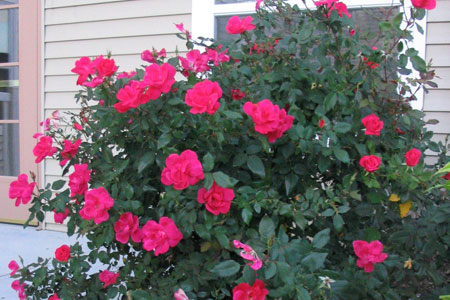
Now is the time to prepare your roses for another growing season. Many gardeners are hesitant to prune landscape roses, fearing they will do something wrong and damage or kill the plants. However, pruning provides several benefits including:
- Improved flower quality.
- Improved plant health through increased air movement around and through plant foliage.
- Maintains plant shape and size so that it fits into your landscape.
Popular shrub roses that perform well and are widely used in Nebraska landscapes include older, traditional cultivars such as 'The Fairy', 'Frau Dagmar Hastrup', 'Harison's Yellow', 'Seafoam', 'Meidiland' and 'Hansa'. Newer cultivars include 'Nearly Wild', and rose series such as Knock Out, Carefree, and Morden. The "Buck" roses, developed by Dr. Griffith Buck, former professor at Iowa State University are also primarily shrub roses. All of these rose series feature lower maintenance, greater disease resistance and increased winter hardiness along with their beautiful flowers. English roses, such as the David Austin series, are also considered shrub roses.
Timing
Shrub roses should be pruned in late winter, late February or March, preferably while still dormant or just as the buds begin to swell and new growth emerges. When dormant pruning, living stems can be identified by the green color of the bark. Stems, or branch tips that have died will be dark brown or black in color. Beginning gardeners may want to delay pruning until new growth begins, which allows them to see exactly where healthy tissue is located, making it easy to remove any stems that have died.
Shrub roses do not require the hard pruning usually associated with hybrid tea roses, however, some can tolerate severe pruning. How far back plants are pruned will affect plant height in summer, with plants that are more severely pruned staying shorter. For most gardeners, it's best to remove one-half to two-thirds of the plant's height during early spring pruning. This removes winter-killed branch tips and allows the plant to initiate new growth on thick stems that will support summer's growth.
Getting Started
Following a sequence of steps when pruning shrub roses can make the process seem less complicated.
First, think about thinning. If your plant has been in the landscape for several years, the center may have become crowded with stems, some of which are probably thick and woody. It can be beneficial to remove a portion of those stems each year. This will encourage growth of new, vigorous stems from the plant crown and eliminates the development of many old, woody branches with poor flower production. It also increases air circulation through the plant, reducing potential for disease problems. Simply select up to one-third of the thickest stems, and prune them back as close to the crown as possible. If all the stems on your plant are fairly small and still have bright green bark, then skip this step.
Next, remove any remaining dead, diseased or damaged branches. Remove dead wood to the nearest healthy, outward facing bud on a pencil-sized stem. Pith (located in the center of the stem) should be creamy white on healthy, live wood, not brown or gray. If the inside of the stem is brown, prune the cane back farther. Make the cut at least one inch below the dead area. If there are no live buds, remove the entire branch or cane to the base of the plant.
Examine canes carefully for canker (a darkened, sunburned-looking area) or other diseased areas. If disease is found, cut down to a good bud at least one inch below any evidence of disease. Prune to where the pith is healthy or to the plant's crown.
Next, remove up to one-half to two-thirds of the plant height on any remaining tall stems. Preferably this is done with hand pruners making individual cuts, but hedge trimmers can also be used followed by some clean-up cuts to remove any extra long stem stubs and ensure that cuts direct new growth to outward facing buds.
Remove Suckers
Many modern shrub rose cultivars grow on their own roots, compared to plants grafted onto a different type of rootstock. When growing grafted roses, watch for suckers that originated from the rootstock and remove any that appear. Rootstock material is chosen for its vigor and used to increase winter hardiness, not for flower production or attractiveness. Any suckers allowed to remain may eventually overtake the whole plant because of their vigor, and any flowers produced may be a completely different color than the original plant.
Final Steps
Modern shrub roses are bred for season-long bloom, so during the summer deadhead stems as the flowers fade cutting back to pencil-sized stems and an outward facing bud. This will keep your plants looking neat and blooming throughout the summer.